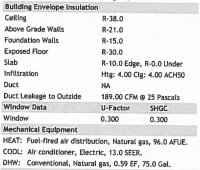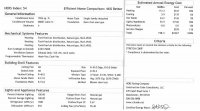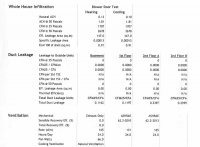I'm building an 8000 sqft (including basement) house outside of Boston. We're trying to choose between forced air and hydro air.
I can't find that much out there about how to power a high-demand shower. We are installing a custom shower with 2.5 GPM showerhead, 2.5 GPM handshower and 3 x 2 GPM body sprays, which can all be run simultaneously (11 GPM). We also have a tub that's 84 gallons to the overflow, but probably will fill it to around 50 gallons. The tub filler is ~14 GPM.
The two proposals are:
(1) forced air and tankless hot water:
5 furnaces (!!!): 1 handling the finished basement, 2 handling the 1st floor, and 2 handling the 2nd floor and not-yet-finished attic. 2 could've handled the downstairs but making it 3 helps with duct constraints.
3 Navien HWHs: 2 cascaded to handle all the upstairs bathrooms including that master shower, and 1 to handle the basement and 1st floor (I think we could do 2 for everything)
(2) boiler + ~80gal indirect or a TurboMax:
still trying to flesh this out. venting and gas lines for 5 furnaces is ugly and expensive which prompted looking into a boiler. I'm not super worried about the HVAC side of that. we'd probably still have 5 air handlers because of ducting.
I've read that tankless hot water is better for big showers. if we go hydro, I feel like we'd need an oversized system to handle that peak load, which would be inefficient most of the time.
the turbomax seems like an interesting option. if i understand it, it's the boiler equivalent of a tankless heater. the HVAC supplier suggested a TurboMax 65 with a ~500k BTU output boiler to do 15GPM @ 110F which seems in line with 2-3 200k BTU Navien 240A's.
But can't a normal indirect heater like the SuperStor handle this? My novice calculations:
11GPM @ 80% hot water = 8.8GPM
80 gal SuperStor SSU-80 = 56 gal usable
SSU-80 first hour recovery @ >= 212k BTU = 330 GPH
Continuous flow = First-hour - (0.75 * tank capacity) = 330 - 0.75 * 80 = 270 GPH = 4.5 GPM
So I *think* this means (and this is where I'd love confirmation/correction) that the shower will drain the tank at 8.8 - 4.5 = 4.3 GPM. That gives us 13 minutes. The 56 gallons is enough to fill the tub.
A more realistic scenario is that we run the body sprays + only one showerhead, 8.5 GPM * 80% = 6.8 GPM, and it lasts 24 minutes (56 gal / (6.8 - 4.5 GPM)). I think 24 minutes is plenty for us both to shower back to back.
I think we could add in a drainwater heat exchanger like the Power-Pipe (confirmed that it's approved in Mass.) to extend it further.
The TurboMax at a similar 250k BTU can do 429 GPH @ 110F, 7GPM. That's not quite enough.
It sounds like the options are a *huge* on demand heater like the TurboMax @ 500k BTUs / 3 Naviens, or a simple traditional tank. What's wrong with my calculations that would justify anything other than the indirect tank and a ~250k BTU boiler?
Thanks!
I can't find that much out there about how to power a high-demand shower. We are installing a custom shower with 2.5 GPM showerhead, 2.5 GPM handshower and 3 x 2 GPM body sprays, which can all be run simultaneously (11 GPM). We also have a tub that's 84 gallons to the overflow, but probably will fill it to around 50 gallons. The tub filler is ~14 GPM.
The two proposals are:
(1) forced air and tankless hot water:
5 furnaces (!!!): 1 handling the finished basement, 2 handling the 1st floor, and 2 handling the 2nd floor and not-yet-finished attic. 2 could've handled the downstairs but making it 3 helps with duct constraints.
3 Navien HWHs: 2 cascaded to handle all the upstairs bathrooms including that master shower, and 1 to handle the basement and 1st floor (I think we could do 2 for everything)
(2) boiler + ~80gal indirect or a TurboMax:
still trying to flesh this out. venting and gas lines for 5 furnaces is ugly and expensive which prompted looking into a boiler. I'm not super worried about the HVAC side of that. we'd probably still have 5 air handlers because of ducting.
I've read that tankless hot water is better for big showers. if we go hydro, I feel like we'd need an oversized system to handle that peak load, which would be inefficient most of the time.
the turbomax seems like an interesting option. if i understand it, it's the boiler equivalent of a tankless heater. the HVAC supplier suggested a TurboMax 65 with a ~500k BTU output boiler to do 15GPM @ 110F which seems in line with 2-3 200k BTU Navien 240A's.
But can't a normal indirect heater like the SuperStor handle this? My novice calculations:
11GPM @ 80% hot water = 8.8GPM
80 gal SuperStor SSU-80 = 56 gal usable
SSU-80 first hour recovery @ >= 212k BTU = 330 GPH
Continuous flow = First-hour - (0.75 * tank capacity) = 330 - 0.75 * 80 = 270 GPH = 4.5 GPM
So I *think* this means (and this is where I'd love confirmation/correction) that the shower will drain the tank at 8.8 - 4.5 = 4.3 GPM. That gives us 13 minutes. The 56 gallons is enough to fill the tub.
A more realistic scenario is that we run the body sprays + only one showerhead, 8.5 GPM * 80% = 6.8 GPM, and it lasts 24 minutes (56 gal / (6.8 - 4.5 GPM)). I think 24 minutes is plenty for us both to shower back to back.
I think we could add in a drainwater heat exchanger like the Power-Pipe (confirmed that it's approved in Mass.) to extend it further.
The TurboMax at a similar 250k BTU can do 429 GPH @ 110F, 7GPM. That's not quite enough.
It sounds like the options are a *huge* on demand heater like the TurboMax @ 500k BTUs / 3 Naviens, or a simple traditional tank. What's wrong with my calculations that would justify anything other than the indirect tank and a ~250k BTU boiler?
Thanks!





